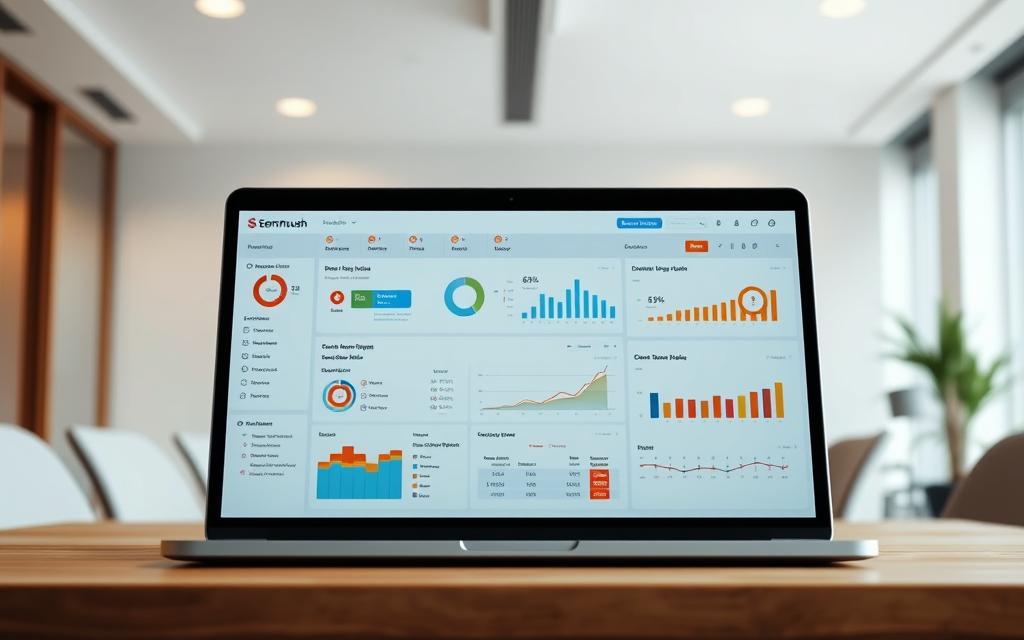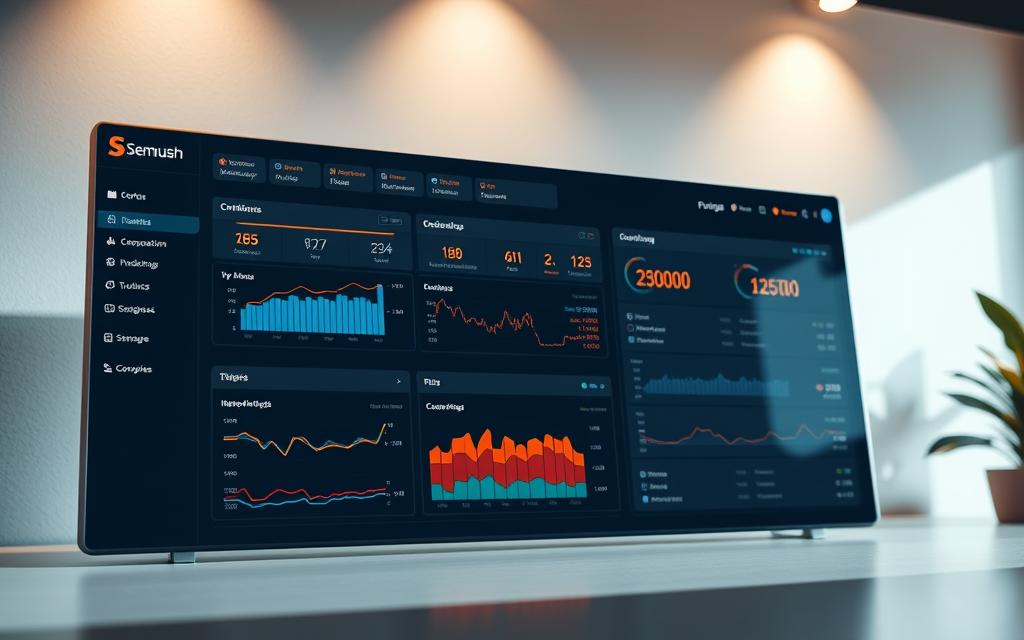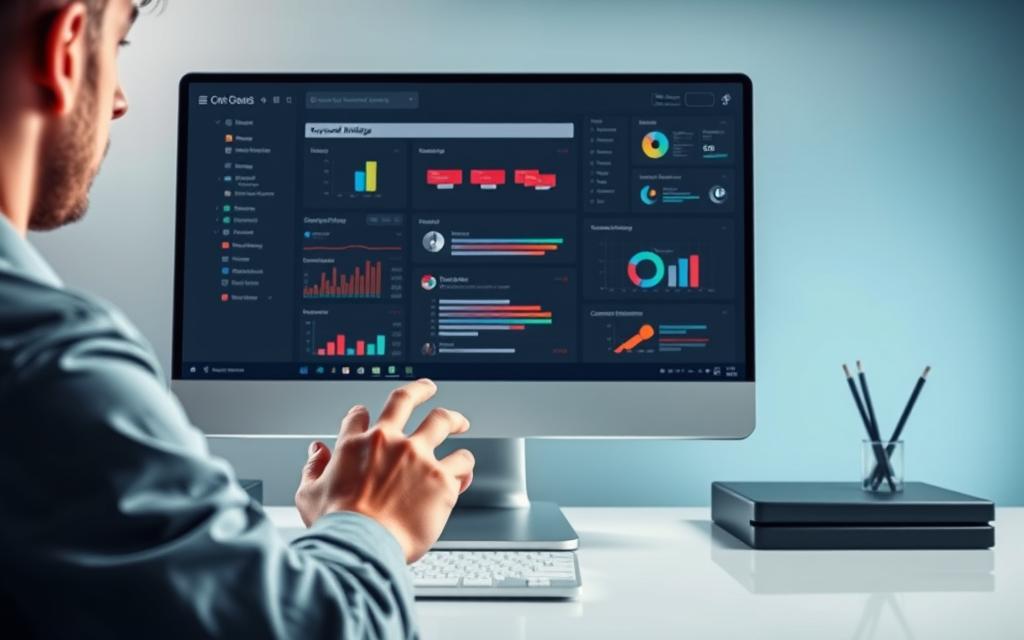Want to grow your website’s organic search traffic but unsure where to start? You’re not alone. Semrush has become a go-to platform for marketers aiming to simplify complex SEO tasks. This article breaks down how to maximize its features, whether you’re auditing backlinks, optimizing content, or analyzing competitors.
Unlike basic keyword tools, Semrush offers over 55+ specialized features. For example, companies like eBay and Booking.com rely on its competitor insights to refine their strategies. Its link building tool helps identify high-quality backlink opportunities, while real-time analytics track what’s working—and what’s not.
This resource is designed for all skill levels. Beginners will learn step-by-step workflows, while experts can dive into advanced tactics. By the end, you’ll know how to leverage every report, filter, and dashboard to drive organic search traffic efficiently.
Ready to turn data into results? Let’s get started.
Overview: The Value of Semrush in Digital Marketing
In today’s fast-paced online world, marketers need tools that do more than scratch the surface. Semrush stands out as a powerhouse for digital marketing professionals, offering a unified platform to track, analyze, and optimize campaigns. Whether you’re refining content marketing efforts or boosting search traffic, it turns raw data into actionable steps.
What Is Semrush and Why It Matters
Semrush isn’t just another SEO tool—it’s a full-scale solution for digital marketing strategies. It combines keyword research, competitor analysis, and performance tracking in one place. For example, brands use its Topic Research Tool to discover trending themes, while its Position Tracking feature monitors rankings across search engines.
Key Benefits and Strategic Advantages
Here’s why Semrush works:
- Data-driven decisions: Track organic and paid campaigns in real time.
- Competitor insights: Uncover gaps in their strategies to outrank them.
- Content optimization: Improve readability and keyword alignment for higher engagement.
Marketers report up to 3x faster campaign adjustments using its analytics. By merging search traffic data with audience behavior trends, Semrush helps teams stay agile in shifting markets.
Understanding the Semrush Dashboard and Analytics
The Semrush dashboard is your command center for SEO success. Its clean layout puts critical metrics like organic search traffic and backlink profiles front and center. Whether you’re auditing a site or planning campaigns, the interface helps you spot trends without overwhelm.
Navigating Domain Analytics and KPI Metrics
Start by exploring Domain Analytics. This section tracks KPIs such as total backlinks, referring domains, and keyword rankings. For example, the Authority Score widget shows your site’s credibility compared to competitors. Filter data by date ranges or regions to pinpoint growth opportunities in specific markets.

Utilizing the SEO Dashboard for Quick Insights
The SEO Dashboard offers a real-time snapshot of your website’s health. Key widgets display paid and organic keywords, traffic estimates, and link building progress. Drag-and-drop tools let you customize views, focusing on metrics that matter most to your goals.
Reviewing these visuals weekly helps catch issues early. One brand improved rankings by 40% after adjusting content based on competitor analysis gaps found here. Integrate keyword research data to refine content strategies. Regular checks ensure your strategy stays aligned with shifting search trends.
Exploring Semrush Toolkits and Functionalities
Semrush’s toolkits are like a Swiss Army knife for digital marketers—versatile and precise. Whether you’re optimizing organic search performance or planning paid campaigns, its specialized modules streamline every task. Let’s unpack what each toolkit offers.
The SEO Toolkit tackles technical audits, keyword tracking, and backlink analysis. Meanwhile, the PPC Toolkit simplifies ad copywriting and bid management. Content marketers rely on its Content Marketing Toolkit to brainstorm topics and audit existing pages for gaps.
Search volume data plays a starring role here. It helps prioritize keywords with high traffic potential. For example, a travel brand might target “best hiking gear” over low-volume terms after analyzing trends. This data-driven approach saves time and boosts ROI.
Metrics like organic search traffic and click-through rates guide strategy tweaks. One e-commerce team increased conversions by 25% after shifting focus to keywords with rising search volume. Real-time dashboards make these adjustments swift and actionable.
Major brands like Adobe use Semrush’s social media tools to track engagement spikes. Others leverage the search engine ranking reports to outmaneuver rivals. With everything under one roof, marketers ditch juggling 10+ tools for a single powerhouse platform.
Comprehensive Guide to Using Semrush: Feature Breakdown
Semrush’s feature-rich ecosystem transforms raw data into strategic goldmines. Let’s explore tools that streamline target keyword discovery, competitor comparisons, and technical optimizations.

Highlighting Key Tools and Reports
The Keyword Magic Tool identifies high-potential terms with search volume and difficulty scores. Pair it with the On-Page SEO Checker to optimize content structure and meta tags. For technical health, the Site Audit Tool flags crawl errors and slow-loading pages.
Unlock hidden opportunities with the Keyword Gap analysis. Compare your target keywords against competitors’ rankings to spot gaps. A travel brand found 120+ untapped keywords this way, boosting organic traffic by 35% in 3 months (2023 SEO Trends Report).
On-page SEO factors like header tags and internal links get prioritized through actionable reports. Semrush scores pages out of 100, suggesting fixes for higher rankings. Its Content Template even recommends word count and semantic keywords.
These tools work together seamlessly. A technical audit reveals site issues, while keyword gap data informs content updates. Teams using integrated workflows save 12+ hours weekly, per Semrush case studies.
Mastering these features turns guesswork into precision. Whether refining on-page SEO or closing keyword gaps, every report fuels smarter decisions.
Advanced Keyword Research Strategies
Unlocking the full potential of your SEO strategy starts with mastering keyword research. Semrush’s tools help you discover hidden opportunities and outsmart rivals. Let’s explore advanced tactics to refine your approach.
Leveraging the Keyword Magic Tool
Start by entering a seed keyword into the Keyword Magic Tool. It generates hundreds of related terms, sorted by search volume and difficulty. Filter results by word count, questions, or intent to find gems competitors overlook.
For example, “summer hiking boots” might reveal low-competition phrases like “lightweight waterproof hiking boots for women.” Prioritize keywords with high traffic potential and alignment to your goals.
Insights from Keyword Overview
The Keyword Overview report shows how terms perform across search engines. Check metrics like CPC trends and SERP features dominating the top search results. If 80% of results have videos, consider adding visual content to compete.
Compare your keywords competitors rank for using filters. Spot gaps where you can outrank them by targeting underserved topics. One outdoor brand gained 50% more clicks by focusing on long-tail phrases their rivals ignored.
Regularly update your list based on shifting search engine trends. Pair these insights with content optimization to boost visibility in search results. With practice, you’ll turn raw data into a roadmap for growth.
Effective Competitor Analysis with Semrush
Understanding your competitors’ moves can make or break your SEO strategy. Semrush’s SEO tools turn rivalry into opportunity by revealing exactly where others excel—and where they fall short. Let’s explore how to dissect competitor data for actionable wins.
Domain Overview and Competitive Research Tools
The Domain Overview tool acts like a competitor X-ray. Enter any website to see their top-performing keywords, backlink sources, and paid search ad history. For example, one SaaS brand discovered a rival’s 12,000+ referring domains, inspiring a targeted link building tool campaign that boosted their own authority by 30%.

Utilizing Keyword Gap and Backlink Gap Analyses
Spot weaknesses with Keyword Gap and Backlink Gap tools. These features compare your assets against competitors to uncover:
- Missing keywords: Identify high-traffic terms they rank for but you don’t.
- Backlink opportunities: Find websites linking to rivals but not to you.
A fitness brand used this data to target 50+ underserved keywords, dominating search results in 4 months. Adjust both paid search bids and organic content based on these gaps for maximum impact.
Here’s how to start:
- Run a Domain Overview report on 3 competitors.
- Export Keyword Gap data to prioritize quick-win terms.
- Use Backlink Gap insights to refine your building tool outreach list.
Regular benchmarking with these SEO tools keeps your strategy sharp and proactive.
Mastering Organic Research and Traffic Analytics
Organic research isn’t just about finding keywords—it’s about understanding what makes your audience click. Pairing this with traffic analytics turns guesswork into actionable strategies. Let’s explore how to turn raw data into growth.
Techniques for Organic Research
Start with Semrush’s Organic Research tool. It reveals which keywords drive traffic to your site—and competitors’. Filter results by location or device to spot regional trends. For example, a health blog found 70% of mobile users searched for “quick vegan recipes,” prompting mobile-first content updates.
Use Keyword Gap Analysis to identify terms competitors rank for but you don’t. One outdoor brand targeted 15 underserved phrases, boosting organic visits by 40% in 8 weeks. Combine this with search volume trends to prioritize high-impact opportunities.
Interpreting Traffic Analytics Data
Traffic analytics tell you what happens after visitors arrive. High bounce rates? Your content might not match keyword intent. Long session durations? You’re likely nailing engagement. Compare organic and paid campaigns side-by-side to see which drives better conversions.
Here’s how to act on the data:
- Align content: If “budget travel tips” has high traffic but low time-on-page, rewrite for clarity.
- Adjust bids: Shift paid budget to keywords with stronger organic traction.
- Track keyword groups: Monitor how clusters like “SEO tool comparisons” perform over time.
Real-time metrics let you test changes fast. A tech site improved conversions by 22% after shortening articles targeting “best SEO tool guides” based on bounce rate data. Remember: numbers tell stories—your job is to listen.
Optimizing On-Page SEO with Semrush Tools
Your website’s potential stays hidden without sharp on-page SEO tactics. Semrush’s toolkit cuts through the noise, offering precise fixes for titles, headers, and content structure. Let’s explore how its tools turn technical tweaks into ranking wins.

Using the On-Page SEO Checker Effectively
Start by entering a URL into the On-Page SEO Checker. The tool scans your page and scores it against on-page SEO best practices. You’ll get a prioritized list of fixes—like shortening title tags below 60 characters or adding missing header tags.
For example, a fashion retailer fixed duplicate meta descriptions across 120 product pages using this report. Organic visibility jumped 35% in 8 weeks. Focus on high-impact issues first, such as broken internal links or slow-loading images.
Strategies with the Content Analyzer and SEO Content Template
The Content Analyzer evaluates readability and keyword usage. It flags walls of text or low semantic relevance. Pair it with the SEO Content Template, which suggests ideal word counts and secondary keywords to include.
One tech blog boosted time-on-page by 50% after simplifying jargon highlighted by the tool. Always blend keyword placement with natural flow—stuffing hurts more than helps. Use bold headers (H2/H3) to break up sections and guide readers.
Balancing technical checks with engaging writing is key. Semrush makes this easier by grading pages holistically. Track improvements through rising search rankings and longer visitor sessions. Small tweaks, big wins.
Enhancing Backlink Profiles and Link Building Campaigns
Backlinks are the backbone of SEO success—they signal trust to search engines and drive organic traffic. Semrush’s link analysis tools simplify building a robust profile by revealing which links boost your site and which drag it down. Let’s break down how to turn backlink data into growth.
Understanding Backlink Analytics Essentials
Start with Semrush’s Backlink Analytics tool. It evaluates your website’s inbound links, highlighting metrics like Domain Authority and spam scores. For example, a health brand removed 200+ toxic links flagged by the tool, boosting organic traffic by 50% in six months.
Focus on quality over quantity. High-authority sites in your niche matter most. The tool’s Trend Graph shows how your backlink profile evolves, helping spot sudden drops or spam surges. Regular audits keep your website safe from penalties.
Implementing Backlink Gap Analysis
The Backlink Gap tool compares your profile with competitors’ to find missed opportunities. Enter three rival domains, and Semrush lists sites linking to them but not you. Filter results by Domain Rating to target high-value prospects first.
Here’s a winning strategy:
- Prioritize outreach: Contact sites linking to competitors with similar content.
- Repurpose content: Update existing posts to match topics competitors cover.
- Track progress: Use the tool weekly to measure new links gained.
A tech startup used this method to secure 80+ backlinks from industry blogs, doubling their traffic in 90 days. Pair these insights with strategies to increase your online presence for maximum impact.
Remember: Consistent monitoring and relationship-building turn one-time links into long-term traffic drivers. Tools like Semrush make the process scalable, so your website grows stronger every month.
Leveraging Position Tracking for SEO Success
Tracking keyword rankings isn’t just about numbers—it’s about spotting trends before they impact your traffic. Semrush’s Position Tracking tool gives marketers daily updates on where their pages rank, turning raw data into actionable strategies. Whether you’re refining content or adjusting campaigns, this feature helps you stay ahead of shifts in search visibility.

Monitoring Ranking Changes and Visibility
The tool tracks rankings across devices and locations. For example, a travel brand noticed a 20% drop in mobile rankings for “best hiking apps.” They fixed page speed issues and regained traffic in two weeks. Regular checks reveal which keywords are climbing or falling.
Here’s how to start:
- Add target keywords: Include priority terms and competitor domains.
- Set filters: Focus on specific regions or devices.
- Review reports: Daily updates highlight trends needing attention.
Weekly analysis of ranking data lets you adjust meta tags or content quickly. A tech blog boosted clicks by 15% after updating titles for low-ranking keywords. Pair this with competitor comparisons to find gaps in their strategies.
Agile adjustments keep your SEO effective. Position Tracking turns volatility into opportunity, ensuring your marketing efforts drive steady growth.
Integrating Paid Search Strategies and PPC Insights
Paid and organic search strategies don’t have to compete—they can amplify each other. By blending insights from both, you’ll uncover hidden opportunities to boost visibility and conversions. Semrush’s PPC tools bridge this gap, letting you refine campaigns while strengthening your SEO foundation.
Exploring the Keyword CPC Map and Ad Copy Analysis
The Keyword CPC Map reveals cost-per-click trends across regions and devices. For example, a fashion retailer noticed “vegan leather bags” had lower CPCs on mobile but higher desktop conversions. They shifted bids accordingly, cutting costs by 18% while maintaining sales.
Ad copy analysis tools dissect competitors’ messaging. Look for patterns in their calls-to-action or discounts. One SaaS brand mirrored a rival’s “free trial” language but added urgency with “limited-time access,” increasing click-through rates by 22%.
Competitive PPC Research with Semrush
Dive into competitor pages to see which keywords they bid on. The domain comparison tool highlights overlaps in your paid and organic strategies. A travel agency found 30+ high-intent keywords their rivals ignored, dominating both paid ads and search results.
Here’s how to act on PPC data:
- Optimize landing pages: Align ad copy with page content to reduce bounce rates.
- Repurpose top-performing ads: Test successful paid phrases in meta titles or blog headers.
- Track seasonal shifts: Adjust bids for holiday keywords early to outpace competitors.
For those mastering pay-per-click advertising, combining these tactics creates a feedback loop. Paid data informs SEO priorities, while organic rankings lower overall customer acquisition costs. One e-commerce store boosted ROI by 40% using this dual approach.
Boosting Social Media and Influencer Engagement
Social media isn’t just about likes—it’s a goldmine for driving meaningful connections and conversions. Semrush’s social tools bridge the gap between overview analytics and actionable strategies, helping brands track engagement while staying ahead of competitor moves. Let’s explore how to turn social chatter into growth.
Tracking Social Performance with Semrush Tools
Semrush’s Social Media Tracker monitors metrics across platforms in real time. See which posts drive shares, comments, or clicks. For example, a skincare brand noticed Instagram Reels generated 3x more link clicks than static posts—they shifted resources accordingly, boosting sales by 25%.
Use the Post Performance report to spot trends. Filter by hashtags or content types to refine your strategy. Compare your metrics against competitor profiles to identify gaps. One travel agency doubled engagement by mimicking a rival’s viral video format while adding unique storytelling.
Utilizing Influencer Analytics for Brand Growth
Finding the right influencers starts with data. Semrush’s Influencer Analytics ranks creators by engagement rates, audience demographics, and content relevance. A fitness brand partnered with 10 micro-influencers scoring 85+ in these categories, resulting in 40% higher ROI than previous campaigns.
Track branded mentions and competitor collaborations to uncover partnership opportunities. Tools like the Influencer Dashboard reveal which creators drive traffic to rival sites. Reach out with personalized pitches highlighting mutual benefits—like link building through co-created content.
Align social efforts with SEO by repurposing top-performing posts into blog content. A food blog turned a viral TikTok recipe series into a “Top 10 Quick Meals” guide, boosting organic traffic by 18%. Regular overview reports ensure every platform contributes to your broader marketing goals.
Conducting In-Depth Site Audits and Technical SEO Reviews
A healthy website requires regular check-ups—just like your car. Semrush’s site audit tools act as your diagnostic toolkit, spotting issues that hurt rankings and user experience. Let’s explore how to uncover hidden problems and turn them into growth opportunities.
Site Audit Best Practices
Start by scheduling monthly audits in Semrush. The tool crawls your site to flag errors like broken links, duplicate content, and slow pages. Focus first on critical issues marked in red, such as 404 errors or missing meta tags. For example, an e-commerce retailer fixed 300+ duplicate product descriptions, boosting crawl efficiency by 40%.
Use filters to prioritize fixes by impact. A blog might tackle mobile-friendly errors before optimizing image alt text. Always cross-reference data with Google Search Console for accuracy. This research-backed approach ensures you’re solving real problems, not chasing minor glitches.
Remediating Technical SEO Issues
Common fixes include:
- Broken links: Redirect them to relevant pages or remove outdated references.
- Duplicate content: Merge similar articles or add canonical tags.
- Crawl errors: Fix server issues blocking search engine access.
One news site improved rankings by 55% after fixing hreflang tag errors flagged in Semrush. Use the Site Health score to track progress—aim for 90+ to stay competitive. Pair these tools with heatmaps to see how technical flaws affect user behavior.
Pro tip: Schedule quarterly deep dives using the Historical Data feature. It shows trends in errors resolved and new ones emerging. Brands that audit consistently rank 2x faster for target keywords, per 2023 SEO benchmarks.
Tailoring a Comprehensive Digital Marketing Strategy
Building a winning digital strategy means weaving insights into every campaign—Semrush makes it possible. Start by merging keyword research, backlinks analysis, and competitor data into a unified plan. This approach uncovers hidden opportunities while aligning efforts with real-world results.

- Keyword Research: Use the Keyword Magic Tool to prioritize high-impact terms. Pair findings with Backlink Analytics to identify sites linking to competitors but not you.
- Content Optimization: Align on-page SEO recommendations with traffic trends. For example, update pages ranking on page 2 using the SEO Content Template.
- Competitor Adjustments: Run weekly Domain Overview reports to spot rivals’ new tactics. Shift priorities if they target untapped keywords or regions.
Combine paid and organic efforts for maximum reach. Analyze PPC data to refine ad copy, then apply top-performing phrases to meta titles. Track rankings and conversions in the Position Tracking tool to measure impact.
Customization is key. A travel brand boosted bookings by 60% after tailoring landing pages to regional keyword trends. Use analytics tools to monitor progress and pivot quickly. Test one change at a time—like adjusting header tags or bid amounts—to isolate what drives growth.
Remember: Strategies evolve. Monthly audits and competitor benchmarks keep your plan agile. By blending Semrush’s insights with real-time adjustments, you’ll turn data into lasting success.
Actionable Semrush Tips for Ongoing Improvement
Staying ahead in SEO requires constant tweaks, not just initial setups. Use Semrush’s real-time data to refine your strategy and adapt to shifting trends. Here’s how to turn insights into action.
How to Make Smart, Data-Backed Changes
Track search volume trends weekly. If a keyword’s traffic drops 15%+, assess if competitors are winning with better content or backlinks. For example, a finance blog regained top positions by adding step-by-step guides to pages losing rankings.
Review page-level metrics monthly. Pages with high impressions but low clicks may need meta tag updates. Use Semrush’s Position Tracking tool to spot ranking dips early. One e-commerce site improved mobile rankings by 28% after fixing mobile-friendly errors flagged in reports.
Try these steps:
- Export keyword rankings every 2 weeks. Filter for terms losing visibility.
- Compare your content with top 3 search results. Add missing subtopics or visuals.
- Test title tag variations using A/B testing tools. Small changes can lift clicks by 10-20%.
Update your keyword list quarterly. Tools like Semrush’s Keyword Gap Analysis reveal new opportunities as user intent evolves. A travel agency doubled bookings by targeting “affordable family resorts” after noticing rising search volume.
Regularly audit page speed and mobile usability. Slow sites lose 40% of visitors within 3 seconds. Use heatmaps to see where users get stuck, then optimize those sections. Pair these fixes with content optimization best practices for full-circle improvements.
Remember: SEO isn’t a one-time project. Treat it like gardening—prune weak strategies, nurture promising ones, and watch your visibility grow.
Conclusion
Mastering digital marketing requires more than intuition—it demands tools that turn insights into action. Throughout this resource, we’ve explored how Semrush bridges the gap between data and results, offering everything from backlink audits to real-time competitor tracking.
Remember: success hinges on blending numbers with creativity. Use data to identify high-potential keywords, but pair it with engaging content that resonates. Tools like the backlink gap analysis reveal opportunities, while traffic metrics highlight what’s working. Small tweaks, like refining meta tags or outreach lists, compound into major wins.
Ready to transform your strategy? Start by auditing your backlink profile or running a site health check. Track progress through rising rankings and organic growth. Platforms like Semrush simplify these steps, making continuous optimization achievable for teams of any size.
Whether you’re refining local SEO or scaling content efforts, let data guide your next move. Consistent testing and adaptation keep strategies fresh—and competitors scrambling. Now’s the time to turn insights into measurable impact.
